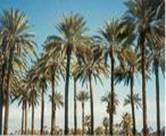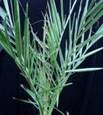| Kingdom | Plantae |
| Unranked | Angiosperms |
| Unranked | Monocots |
| Order | Arecales |
| Family | Arecaceae |
| Genus | Phoenix |
| Species | P. dactylifera |
| Binomial name | Phoenix dactylifera |
Other Common Names:
The other common names for the tree date palm tree are palm tree and date tree.
History
Dates have been a staple food of the Middle East for thousands of years. The origins of the date palm cannot be stated with certainty, as there is evidence of its existence in the Middle East throughout history, and date pits as old as 6500 years have been found in Egypt. They are believed to have originated around the Persian Gulf, and have been cultivated since ancient times from Mesopotamia to prehistoric Egypt, possibly as early as 6000 BC.

Description
A medium-sized tree, date palm grows approximately 15-25m tall, often with several clumped trunks emerging from a single root system. .The trunk is surrounded from the ground upward in spiral pattern with the base of earlier formed leaves (leaf scars).Leaves are large (4-5 m) alternate, sheathing, in dense terminal rosettes, pinnately lobed. The end of the leaf fronds are needle sharp. They are dioecious with female and male individuals. Flowers are borne in bunches at the top of the tree.


Range
The date palm tree is widely distributed in the desert belt of North Africa and the Middle East.
Habitat
Date palm needs a climate with much sun, minimal rain, yet good access to water, which to a large extent is only provided by oases. They are very Cold tolerant, salt tolerant; they can also take extreme heat, dry and wet conditions.
Cultivation
There are two common methods that are used to propagate palm trees, sexually by seed and asexually using offshoots. The small-sized offshoot is removed from the mother plant with a locally made machete and placed in moist place either in the falaj or under the farm trees to provide shade and allow roots to develop. Generally, no green leaves are removed from the offshoot until it is cut from the parent palm, as the growth of an offshoot will be proportional to its leaf area. Separation of the offshoots normally carried out in the late summer and fall. After the root develops, the young trees are transplanted to their permanent place. The new palms normally planted on a hole that is 80cm wide and 80 cm deep in a conic shape. The hole is normally prepared by adding organic manure and loose clean sand with ash before placing the tree in it. In the past, the good cultivars were scarce and expensive, so farmers tended to grow a mixture of different cultivars in the single farm. There are certain times of the year when offshoots are separated from the mother plant, thus moderate temperature is preferred for transplanting offshoots. Although offshoot could be planted in all months of the year, farmers tend to avoid planting in the summer when the temperature is very high or in the winter when temperature is very cold, and their practice is evenly divided between early spring and fall. After planting, the new trees are watered daily for the first week and then once week as the case of the whole farm. Young date palms are planted close old trees in order to be replaced when the young tree start producing fruits. There is no specific spacing but normally it is around 30ft x 30ft interplanted with fruit trees such as citrus or field crops such as barley and alfalfa.
Blooming Habits
The flowers are dioecious where the flower stalk comes from among the leaves.
Pests and Diseases
Date Palms are susceptible to a disease called Bayoud disease which is caused by the fungus Fusarium oxysporum. This disease, which kills many of the popular older cultivars like 'Deglet Noor', has led to a major decline in production where it is present, notably Morocco and western Algeria. However, new cultivars resistant to the disease are being developed.
Parts Used

The most commonly used parts of the date palm tree are the fruits,bark and the leaves for its commercial and medicinal applications.
Medicinal Applications

• Dates may be administered for sore throat, colds, bronchial catarrh, and taken to relieve fever and number of other complaints in the form of infusion, syrup and paste.
• A gum that exudes from the wounded trunk is employed in India for treating diarrhea and genito-urinary ailments.
• It can help in countearcting alcohol intoxication.
• The roots are used against toothache.
• It is used as a detersive and an astringent in intestinal troubles.
Commercial Applications


• This is a spectacular palm for landscaping large areas.
• Dried leaf petioles are a source of cellulose pulp, used for walking sticks, brooms, fishing floats and fuel.
• The tree itself is utilized in many different ways, as timber, building material, handicrafts, rope and feed for animals.
• Branches and leaves of the palm were used to make baskets, ropes, boxes, and crates.
• It is also used for construction such as bridges and aqueducts, and parts of dhows.
• Dates can also be chopped and used in a range of sweet and savoury dishes, from tajines (tagines) in Morocco to puddings, bread, cakes and other dessert items.
• A viscous, thick syrup made from the ripe fruits is used as a coating for leather bags and pipes to prevent leaking.
• Date oil is suitable for use in soap and cosmetics.
• Dates are also processed into cubes, paste, spread, date syrup or "honey" called "dibs", powder (date sugar), vinegar or alcohol.

The True Date Palm is often mentioned in the bible, rendered on Egyptian tomb walls, and extensively used to spiff up Las Vegas hotels, this is a Sun Palm Trees' favourite and has a long and fascinating role in humankind's history. Dates are an important traditional crop in Iraq, Arabia, and north Africa west to Morocco and are mentioned in many places in the Quran. In Islamic countries, dates and yogurt or sometimes milk are a traditional first meal when the sun sets during Ramadan. Date palm leaves are used for Palm Sunday in Christian religion. There are forty-two Biblical references to the date palm (Moldenke and Moldenke, Plants of the Bible, 1952). An emblem of victory in Greco-Roman tradition, the palm was adopted as one of the earliest and most important plant symbols in the Christian Church, and was an emblem of the martyred saints in their victory over sin and death.
A festival known as "palm Sunday" is celebrated by Christians to commemorate the entry of Jesus into Jerusalem just a few days before his crucifixion. People welcomed Jesus by waving palm fronds and carpeting his path with palm leaves. Identified in the ancient Near East with the Tree of Life, the palm has both religious and artistic significance in Jewish, Islamic, and Christian tradition as a symbol of grace, elegance, victory, wealth, and fecundity and is frequently associated with Paradise in medieval and Renaissance art and literature.